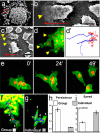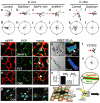Contact inhibition of locomotion in vivo controls neural crest directional migration
- PMID: 19078960
- PMCID: PMC2635562
- DOI: 10.1038/nature07441
Contact inhibition of locomotion in vivo controls neural crest directional migration
Abstract
Contact inhibition of locomotion was discovered by Abercrombie more than 50 years ago and describes the behaviour of fibroblast cells confronting each other in vitro, where they retract their protrusions and change direction on contact. Its failure was suggested to contribute to malignant invasion. However, the molecular basis of contact inhibition of locomotion and whether it also occurs in vivo are still unknown. Here we show that neural crest cells, a highly migratory and multipotent embryonic cell population, whose behaviour has been likened to malignant invasion, demonstrate contact inhibition of locomotion both in vivo and in vitro, and that this accounts for their directional migration. When two migrating neural crest cells meet, they stop, collapse their protrusions and change direction. In contrast, when a neural crest cell meets another cell type, it fails to display contact inhibition of locomotion; instead, it invades the other tissue, in the same manner as metastatic cancer cells. We show that inhibition of non-canonical Wnt signalling abolishes both contact inhibition of locomotion and the directionality of neural crest migration. Wnt-signalling members localize at the site of cell contact, leading to activation of RhoA in this region. These results provide the first example of contact inhibition of locomotion in vivo, provide an explanation for coherent directional migration of groups of cells and establish a previously unknown role for non-canonical Wnt signalling.
Figures




References
-
- Abercrombie M, Heaysman JEM. Observations on the Social Behaviour of Cells in Tissue Culture .I. Speed of Movement of Chick Heart Fibroblasts in Relation to Their Mutual Contacts. Exp. Cell Res. 1953;5:111–131. - PubMed
-
- Abercrombie M, Heaysman JEM. Observations on the social behaviour of cells in tissue culture : II. “Monolayering” of fibroblasts. Exp. Cell Res. 1954;6:293–306. - PubMed
-
- Abercrombie M, Heaysman JE. Invasiveness of sarcoma cells. Nature. 1954;174:697–698. - PubMed
-
- Paddock SW, Dunn GA. Analysing collisions between fibroblasts and fibrosarcoma cells: fibrosarcoma cells show an active invasionary response. J. Cell Sci. 1986;81:163–187. - PubMed
-
- Abercrombie M. Contact Inhibition and Malignancy. Nature. 1979;281:259–262. - PubMed
Publication types
MeSH terms
Substances
Grants and funding
- G117/506/MRC_/Medical Research Council/United Kingdom
- G0400559/MRC_/Medical Research Council/United Kingdom
- BB/D017521/1/BB_/Biotechnology and Biological Sciences Research Council/United Kingdom
- G0801145/MRC_/Medical Research Council/United Kingdom
- G0401026/MRC_/Medical Research Council/United Kingdom
LinkOut - more resources
Full Text Sources
Other Literature Sources
Molecular Biology Databases

